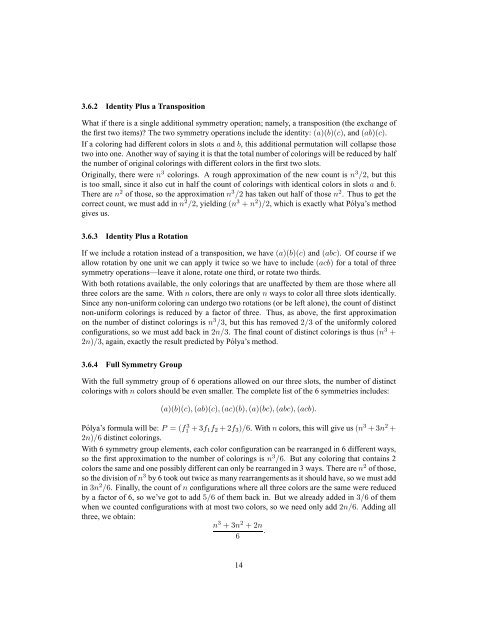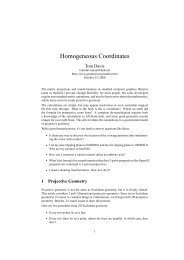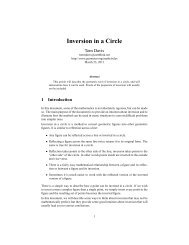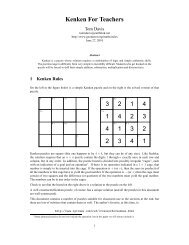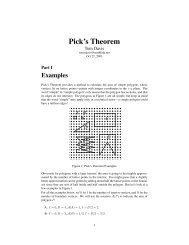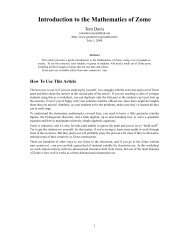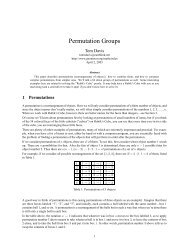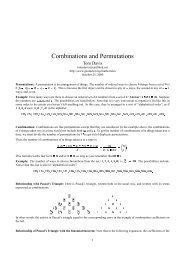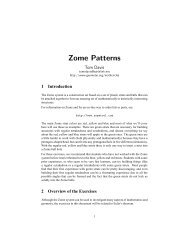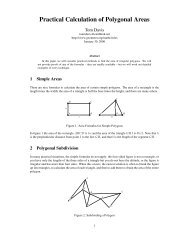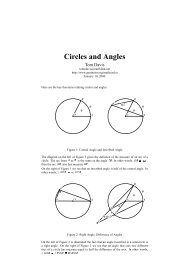P´olya's Counting Theory - Home Page -- Tom Davis
P´olya's Counting Theory - Home Page -- Tom Davis
P´olya's Counting Theory - Home Page -- Tom Davis
Create successful ePaper yourself
Turn your PDF publications into a flip-book with our unique Google optimized e-Paper software.
3.6.2 Identity Plus a Transposition<br />
What if there is a single additional symmetry operation; namely, a transposition (the exchange of<br />
the first two items)? The two symmetry operations include the identity: (a)(b)(c), and (ab)(c).<br />
If a coloring had different colors in slots a and b, this additional permutation will collapse those<br />
two into one. Another way of saying it is that the total number of colorings will be reduced by half<br />
the number of original colorings with different colors in the first two slots.<br />
Originally, there were n 3 colorings. A rough approximation of the new count is n 3 /2, but this<br />
is too small, since it also cut in half the count of colorings with identical colors in slots a and b.<br />
There are n 2 of those, so the approximation n 3 /2 has taken out half of those n 2 . Thus to get the<br />
correct count, we must add in n 2 /2, yielding (n 3 + n 2 )/2, which is exactly what Pólya’s method<br />
gives us.<br />
3.6.3 Identity Plus a Rotation<br />
If we include a rotation instead of a transposition, we have (a)(b)(c) and (abc). Of course if we<br />
allow rotation by one unit we can apply it twice so we have to include (acb) for a total of three<br />
symmetry operations—leave it alone, rotate one third, or rotate two thirds.<br />
With both rotations available, the only colorings that are unaffected by them are those where all<br />
three colors are the same. With n colors, there are only n ways to color all three slots identically.<br />
Since any non-uniform coloring can undergo two rotations (or be left alone), the count of distinct<br />
non-uniform colorings is reduced by a factor of three. Thus, as above, the first approximation<br />
on the number of distinct colorings is n 3 /3, but this has removed 2/3 of the uniformly colored<br />
configurations, so we must add back in 2n/3. The final count of distinct colorings is thus (n 3 +<br />
2n)/3, again, exactly the result predicted by Pólya’s method.<br />
3.6.4 Full Symmetry Group<br />
With the full symmetry group of 6 operations allowed on our three slots, the number of distinct<br />
colorings with n colors should be even smaller. The complete list of the 6 symmetries includes:<br />
(a)(b)(c), (ab)(c), (ac)(b), (a)(bc), (abc), (acb).<br />
Pólya’s formula will be: P = (f1 3 + 3f 1 f 2 + 2f 3 )/6. With n colors, this will give us (n 3 + 3n 2 +<br />
2n)/6 distinct colorings.<br />
With 6 symmetry group elements, each color configuration can be rearranged in 6 different ways,<br />
so the first approximation to the number of colorings is n 3 /6. But any coloring that contains 2<br />
colors the same and one possibly different can only be rearranged in 3 ways. There are n 2 of those,<br />
so the division of n 3 by 6 took out twice as many rearrangements as it should have, so we must add<br />
in 3n 2 /6. Finally, the count of n configurations where all three colors are the same were reduced<br />
by a factor of 6, so we’ve got to add 5/6 of them back in. But we already added in 3/6 of them<br />
when we counted configurations with at most two colors, so we need only add 2n/6. Adding all<br />
three, we obtain:<br />
n 3 + 3n 2 + 2n<br />
.<br />
6<br />
14


